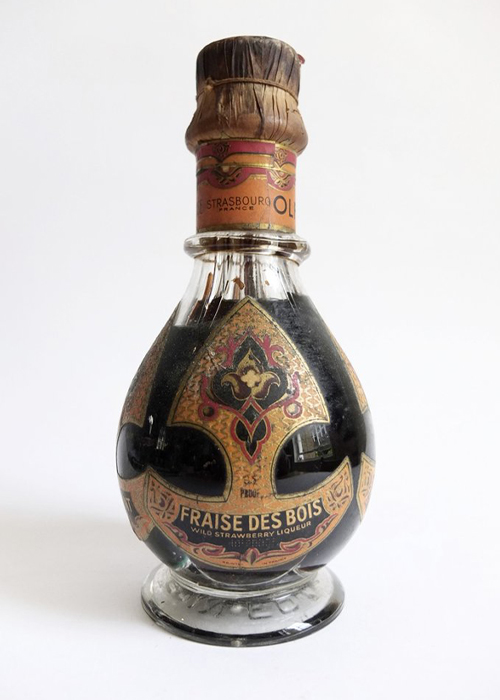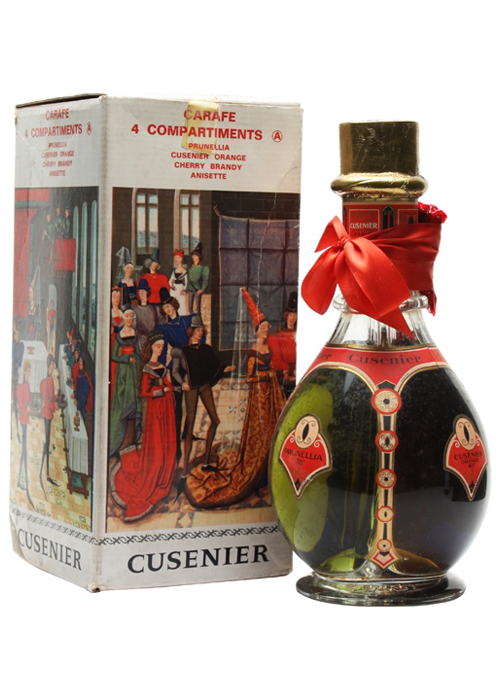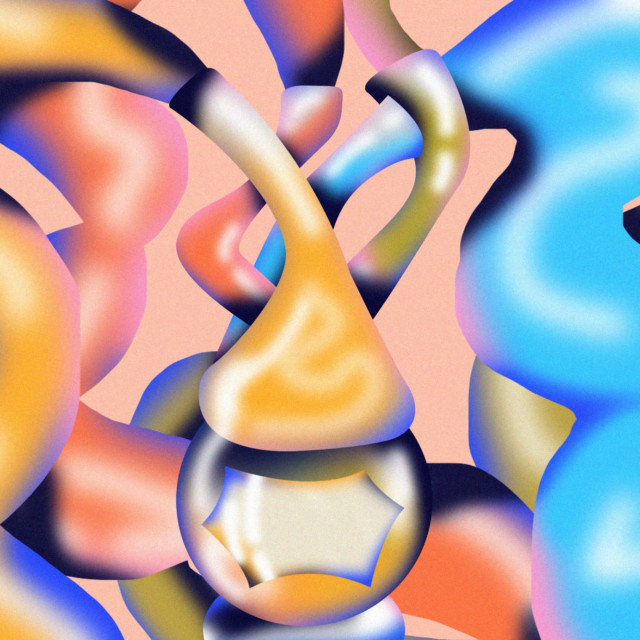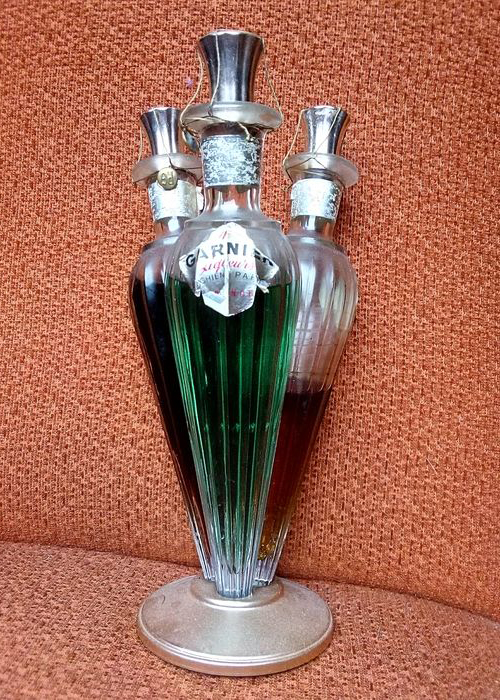On a Season 3 episode of the reality show “Pawn Stars,” a gentleman brings an old bottle into Las Vegas’s Gold & Silver Pawn Shop. Shaped like a bulb, it is clearly hand-blown glass — proprietor Rick Harrison notes the tiny “imperfections” — and stamped “made in France.” Most curiously, it is segmented into four separate chambers, all which taper up toward the neck of the bottle, where there are four separate pour spouts. The owner claims he found the empty, label-less bottle at a garage sale and speculates one would have used it as a decanter, filling each chamber with a different spirit like Scotch or tequila.
“If someone was really, really proud of it, they’d generally put their [brand] name on it,” explains Harrison, thinking it nothing more than a generic, decorative piece. Harrison offers the customer 40 bucks for it, which he gladly accepts.
While Harrison’s offer wasn’t that far off its actual worth, his assessment of the bottle’s purpose was a little wide of the mark.

Trying Something New
To understand the origin of this four-chamber bottle, we must first understand the rise of liqueur in America. By 1962, the U.S. was importing 518,489 gallons of liqueur and the number was steadily rising, having increased 112 percent since 1950 alone. That year, The New York Times noted that this newfound liqueur popularity stateside had “resulted in the introduction of an increasing number of ‘specialty’ drinks and innovations on the part of old-line producers,” specifically mentioning P. Garnier, which, at the time offered 22 different liqueurs.
Founded by one Paul Garnier in 1859, Distillerie P. Garnier was located in Enghien-les-Bains, just north of Paris near ample cherry and apricot orchards. Besides cherry brandy and “Abricotine,” the brand’s proprietary apricot liqueur, Garnier also produced anisette, banana, blackberry, cherry, cocoa, cassis, orange, and peach liqueurs. As of 1885, P. Garnier was being distributed to America, through New York, courtesy Julius Wile Sons & Company, and looking to latch on with consumers.
By at least 1933, they had introduced their first multi-chamber bottle, the “Flacon Quadrille.” It offered four quarter-liters of liqueurs, stacked on top of each other, with pour stouts ascending from the side of the bottle. The liqueurs included were Abricotine, triple sec, Liqueur d’Or (a sort of ur-Goldschläger that had literal gold flakes floating in it), and crème de menthe, which, as of 1935, was “America’s favorite liqueur” according to Harper’s Bazaar.
“Garnier was an OK brand, not as good as Luxardo, but they certainly weren’t a bad brand,” claims Jonah Goodman, a vintage spirits collector who has acquired several Garnier four-chamber bottles over the years. They’re valued at around $100 on the secondary market. “They were just another liqueur brand figuring out how to use their packaging to get a good share of the market,” he says.
And back then, it more or less worked. “Garnier set the trend for these multi-pour packs to convince people to try their range, knowing that most people could only figure out how to use the triple sec and apricot liqueur in drinks,” says Anistatia Miller, an assistant teacher in the Department of History at the University of Bristol (U.K.) and a spirits historian. “The others just enticed people to try something new.”
It was a successful enough ploy for other liqueur companies to follow suit. By the 1950s, Bols, the famed Dutch genever maker founded by Lucas Bols in 1575, was offering a cross-necked two-chamber bottle and “four compartment” bottles mostly mimicking Garnier’s lineup with cherry liqueur, apricot liqueur, triple sec, and crème de menthe.
“I don’t know how they were designed to pour, or how they kept the other three from pouring when one compartment was being decanted,” notes a seller on an online auction site. (For what it’s worth, Goodman claims, “they may look ridiculous,” but you can “unscrew one and it’s actually an easy pour.”)

Cusenier, a once-great family-owned distillery located in the Cognac region (and today a part of Pernod Ricard) similarly offered bulb-shaped four-compartment carafes. Bottlings had everything from orange and cherry liqueur alongside anisette and Prunellia (its proprietary liqueur made with sloe berries and Cognac) to ones with apricot liqueur, crème de cacao, kümmel, and Freezomint (its crème de menthe). Dolfi had a four-chamber bottle with apricot and cherry brandy, peppermint liqueur, and fraise des bois (a wild strawberry liqueur). And D.O.M. would put its iconic Bénédictine and B&B in La Bouteille du Couple.
“There were so many liqueur and eau-de-vie companies in France it’s no surprise the heated competition led to gimmickry,” adds Miller of the trend, which would extend to ceramic decanters and pourable figurines. She explains that when suburban life picked up after the Second World War, the idea of having your own home bar took off like gangbusters until the late 1960s or so, and thusly, “the call for fancy bottles to put on the home back bar were quite the rage.”
These vessels weren’t only a French thing, either. While there were four-chamber releases from Marie Brizard & Roger and Chastenet Frères, both located in Bordeaux, there were also stateside offerings from places like Mohawk Liqueur Co. out of Frankfort, Ky., whose “Cordially Yours” four-compartment bottle had creme de coca (sic), crème de banana, blackberry brandy, and crème de menthe. Houseware stores even sold empty four-chamber bottles as decanters. These and others were frequently advertised around the holidays.
“Which makes sense as there’s a festive element to them, plus they were sold at relatively high prices that would have made them attractive ‘fancy’ gift ideas,” believes Eric Witz, a vintage spirits expert. (One 1945 liquor store ad lists a Garnier four-compartment bottle at a whopping $18.25 — roughly $269 in today’s numbers.)
A true innovator in novelty, multi-product packaging, Garnier would produce numerous combinations over the years, even a three-chamber bottle for a while, with a troika of corked bottles sprouting upward like some sort of strange flower. These and other multi-chamber offerings would last until around 1974, as drinkers moved away from cocktails and more toward wine and beer, with the last of the world’s four-chamber bottlings coming from The Benedictine company, sold under the Garnier name, in 1976.
Are They a Gimmick We Again Need?
Half a century later, we have re-entered another heyday of amateur mixology. I would wager the last year of pandemic life has led to more at-home cocktails being made than at any time in modern American life, with social media visibility pushing those skills one step further. And, yet, so often do I hear the same complaints from aspiring drink-slingers hesitant to get into the kitchen cocktail game.
“Do I really need a bottle of absinthe just to rinse the glass for Sazeracs?”
“Is stocking both Aperol and Campari necessary?”
“Why should I get an $40 bottle of Maraschino liqueur when I only need a teaspoon of it?!”
Bring back the four-chamber bottle I say!
“I could see it being really great if you’re hosting a Bellini brunch or something,” says Nick O’Connell, owner of Post Road Liquors in the Boston area. He thinks a multi-chamber bottle offering different Combier or Giffard liqueurs might be good for such an event. “Put out the [four-chamber] bottle and let guests go to work,” he says.
As a liquor store owner, however, O’Connell admits he’s just not sure these are products the world really needs. He worries he’d essentially be doubling up on his limited shelves by having single bottles of, say, a walnut liqueur, as well as the multi-chamber bottle with the same walnut liqueur in it.
“They’re certainly fun, but it would take up a lot of SKU space,” he explains.
In this era of international conglomerates with ballooning portfolios, though, there’s a lot of room for companies to offer value and tantalize people into trying their more obscure products.
Campari could produce a four-chamber Italian amaro bottle, adding Cynar and Averna alongside Campari and Aperol. Beam-Suntory could “remember the ’80s” with four-chamber DeKuyper schnapps bottles. What about a multi-chamber bottle with sweet, dry, and white vermouth? Heck, Crown Royal could put all their flavored whiskeys in one vessel.
The possibilities are seemingly endless.

